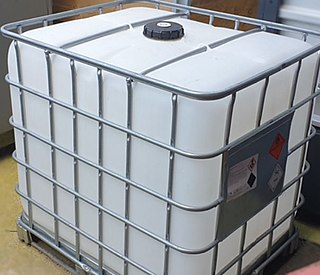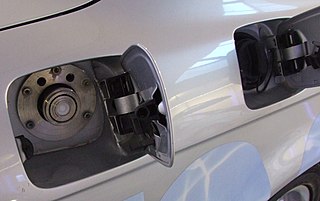Related Research Articles

Liquid hydrogen (LH2 or LH2) is the liquid state of the element hydrogen. Hydrogen is found naturally in the molecular H2 form.
A hydrogen vehicle is a vehicle that uses hydrogen fuel for motive power. Hydrogen vehicles include hydrogen-fueled space rockets, as well as ships and aircraft. Power is generated by converting the chemical energy of hydrogen to mechanical energy, either by reacting hydrogen with oxygen in a fuel cell to power electric motors or, less commonly, by burning hydrogen in an internal combustion engine.
Syngas, or synthesis gas, is a mixture of hydrogen and carbon monoxide, in various ratios. The gas often contains some carbon dioxide and methane. It is principly used for producing ammonia or methanol. Syngas is combustible and can be used as a fuel. Historically, it has been used as a replacement for gasoline, when gasoline supply has been limited; for example, wood gas was used to power cars in Europe during WWII.

Alternative fuel, known as non-conventional and advanced fuels, are any materials or substances that can be used as fuels, other than conventional fuels like; fossil fuels, as well as nuclear materials such as uranium and thorium, as well as artificial radioisotope fuels that are made in nuclear reactors.
The hydrogen economy is using hydrogen to decarbonize economic sectors which are hard to electrify, essentially, the "hard-to-abate" sectors such as cement, steel, long-haul transport etc. In order to phase out fossil fuels and limit climate change, hydrogen can be created from water using renewable sources such as wind and solar, and its combustion only releases water vapor to the atmosphere.
The water fuel cell is a technical design of a "perpetual motion machine" created by American Stanley Allen Meyer. Meyer claimed that an automobile retrofitted with the device could use water as fuel instead of gasoline. Meyer's claims about his "Water Fuel Cell" and the car that it powered were found to be fraudulent by an Ohio court in 1996.
Hydrogen fuel refers to hydrogen which is burned as fuel with oxygen. It is zero-carbon, provided that it is created in a process that does not involve carbon. It can be used in fuel cells or internal combustion engines. Regarding hydrogen vehicles, hydrogen has begun to be used in commercial fuel cell vehicles such as passenger cars, and has been used in fuel cell buses for many years. It is also used as a fuel for spacecraft propulsion and is being proposed for hydrogen-powered aircraft.

Grid energy storage is a collection of methods used for energy storage on a large scale within an electrical power grid. Electrical energy is stored during times when electricity is plentiful and inexpensive or when demand is low, and later returned to the grid when demand is high, and electricity prices tend to be higher.

The methanol economy is a suggested future economy in which methanol and dimethyl ether replace fossil fuels as a means of energy storage, ground transportation fuel, and raw material for synthetic hydrocarbons and their products. It offers an alternative to the proposed hydrogen economy or ethanol economy, though these concepts are not exclusive.

Oxyhydrogen is a mixture of hydrogen (H2) and oxygen (O2) gases. This gaseous mixture is used for torches to process refractory materials and was the first gaseous mixture used for welding. Theoretically, a ratio of 2:1 hydrogen:oxygen is enough to achieve maximum efficiency; in practice a ratio 4:1 or 5:1 is needed to avoid an oxidizing flame.
Hydrogen fuel enhancement is the process of using a mixture of hydrogen and conventional hydrocarbon fuel in an internal combustion engine, typically in a car or truck, in an attempt to improve fuel economy, power output, emissions, or a combination thereof. Methods include hydrogen produced through an electrolysis, storing hydrogen on the vehicle as a second fuel, or reforming conventional fuel into hydrogen with a catalyst.
Fuel-saving devices are sold on the aftermarket with claims they may improve the fuel economy, the exhaust emissions, or optimize ignition, air flow, or fuel flow of automobiles in some way. An early example of such a device sold with difficult-to-justify claims is the 200 mpg‑US (1.2 L/100 km) carburetor designed by Canadian inventor Charles Nelson Pogue.

A bivalent engine is an engine that can use two different types of fuel. Examples are petroleum/CNG and petroleum/LPG engines, which are widely available in the European passenger vehicle aftermarket.
Hydrogen technologies are technologies that relate to the production and use of hydrogen as a part hydrogen economy. Hydrogen technologies are applicable for many uses.
A water-fuelled car is an automobile that hypothetically derives its energy directly from water. Water-fuelled cars have been the subject of numerous international patents, newspaper and popular science magazine articles, local television news coverage, and websites. The claims for these devices have been found to be pseudoscience and some were found to be tied to investment frauds. These vehicles may be claimed to produce fuel from water on board with no other energy input, or may be a hybrid claiming to derive some of its energy from water in addition to a conventional source.

This is a timeline of the history of hydrogen technology.
A water power engine includes prime movers driven by water and which may be classified under three categories:
- Water pressure motors, having a piston and cylinder with inlet and outlet valves: their action is that analogous of a steam- or gas-engine with water as the working fluid – see water engine
- Water wheels
- Turbines, deriving their energy from high velocity jet of jets, or from water supplied under pressure and passing through the vanes of a runner which is thereby caused to rotate
Daniel Dingel (1928–2010) was a Filipino engineer who claimed to have invented a "hydrogen reactor" that could power a water-fuelled car.
The water-kit is a technical design of an alleged "perpetual motion machine" created by Agha Waqar Ahmed, an inventor based in Khairpur, Sindh, Pakistan. In July 2012, Agha Waqar Ahmed's Water-kit was publicly announced as an apparatus that allows water to be used as a source of fuel in cars. The apparatus consists of a "water-kit" that can break water into hydrogen and oxygen molecules through the process of electrolysis of water. Ahmed claims that any car using his kit can run exclusively on water and will yield 40 kilometres (25 mi) of travel on a liter of water.

An internal combustion engine is a heat engine in which the combustion of a fuel occurs with an oxidizer in a combustion chamber that is an integral part of the working fluid flow circuit. In an internal combustion engine, the expansion of the high-temperature and high-pressure gases produced by combustion applies direct force to some component of the engine. The force is typically applied to pistons, turbine blades, a rotor, or a nozzle. This force moves the component over a distance, transforming chemical energy into kinetic energy which is used to propel, move or power whatever the engine is attached to. This replaced the external combustion engine for applications where the weight or size of an engine was more important.
References
- ↑ "The Columbus Dispatch : The car that ran on water". Archived from the original on 2008-02-14. Retrieved 2008-03-24.
- ↑ US 4936961 Meyer water cell
- ↑ US 1262034
- ↑ "Inquirer Article".
- ↑ Archived at Ghostarchive and the Wayback Machine : Water Car ... Daniel Dingel. YouTube .
- ↑ "Inventor, 82, gets 20 years for 'estafa'". Philippine Daily Inquirer. 20 December 2008. Archived from the original on 26 December 2008.
- ↑ "From trash to gas". CNN.
Further reading
- Dunning, Brian (February 12, 2008). "Skeptoid #87: Water: Alternative Fuel of the Future? Cranks love to make the claim on YouTube, but you cannot run your car on water". Skeptoid . Retrieved May 29, 2022.